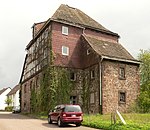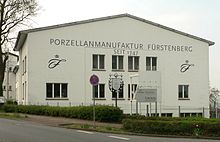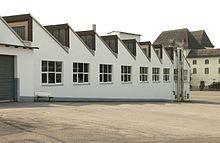Porcelain Manufactory Fürstenberg
| Porcelain Manufactory Fürstenberg GmbH
|
|
|---|---|
| legal form | GmbH |
| founding | 1747 |
| Seat | Fürstenberg , Germany |
| management | Stephanie Saalfeld |
| Number of employees | 99 (2015) |
| sales | 5.4 million EUR (2015) |
| Branch | porcelain |
| Website | www.fuerstenberg-porzellan.com |


The Fürstenberg Porcelain Manufactory is a porcelain manufacture in Fürstenberg in Lower Saxony . It was founded there in 1747 and had its seat in Fürstenberg Castle from around 1750 . In 1972 production was relocated to a new production building next to the castle. The porcelain is marketed as the "white gold of the Weser ". The porcelain manufactory has been a stock corporation since 1888 , 98 percent of which has been owned by the Norddeutsche Landesbank since 1970 . The remaining two percent belong to the Holzminden district. Due to the difficulties of the Nord LB, the takeover of the porcelain factory by the state of Lower Saxony is under discussion at the beginning of 2019.
history
founding
Fürstenberg is the second oldest porcelain manufacturer in Germany that has been producing at the same location to this day . The manufacture was founded on January 11, 1747 by the court hunter Johann Georg von Langen (1699–1776) on behalf of Duke Karl I von Braunschweig-Wolfenbüttel (1713–1780). It was founded in the course of the duke's cameralistic economic and population policy and served to set up a manufacturing business in Braunschweig's Weser district during the period of flourishing mercantilism . At Fürstenberg, the rich wood stocks and the regional raw material kaolin , which was mined at Neuhaus im Solling and processed in the glaze mill in the village of Fohlenplacken , offered themselves for economic use . The production of real porcelain for the market only came about after several years of experimentation. The first fire of over 100 dishes in a new porcelain kiln succeeded in 1750. However, there is considerable doubt that it was real porcelain, since clay and not kaolin was used.
The manufacturing company for the production of porcelain was built around 500 meters east of Fürstenberg Castle . In the old mill as a stone building with a half-timbered top, built from 1744 by the inventor Johann Bessler as a windmill , a laboratory with drying and kilns was set up in 1747 . The alleged arcanist Johann Christoph Glaser , who had offered his services to manufacture porcelain, lived and worked there. In addition to the old mill , the old distillery was built around 1748–1750 , which was used as a distillery for porcelain in the early years. During excavations lasting several years from 2009 to 2012, the first kilns of the porcelain factory from around 1748–1750 were uncovered, which are considered to be the oldest preserved porcelain kilns in Europe.
In 1751 the porcelain factory had 17 employees, including bossers, lathe operators, formers, master distillers and smelter.
The old mill with the first laboratory and experimental kilns
Street view of the old distillery
Building the Long line than previous company housing the factory employees
Start of operation
When in 1753 the right porcelain mass had still not been found, the arcanist Johann Christoph Glaser, employed as technical director, was dismissed in dishonor. It was not until the arcanist Johann Kilian Benckgraff , who was poached by the Höchst Porcelain Manufactory , that the knowledge of porcelain production came to Fürstenberg in 1753 and production began with high numbers. In the same year, Duke Karl I ordered the porcelain pieces to be marked with a blue "F". In order to tie well-known artists to the manufactory, six upscale terraced houses were built for lathe operators, formers and porcelain painters in 1754 with the Long Row . With their mansard roofs, they create a castle-like impression and are an early example of company housing.
From the reports of the court hunter Johann Georg von Langen to Duke Karl I it can be seen that from around 1750 the castle building Fürstenberg was included in the manufacturing operations. Regular production required major renovation work in Fürstenberg Castle, which took place from 1755 to 1757. This included the construction of kilns in the castle building and in the castle moat, the installation of wood stores and the establishment of workrooms for lathe operators, painters and formers. In the roughly 200-year production period, the development in the castle area continued to grow. In 1840, a low-rise building for the turning shop was placed in front of the renaissance facade of the castle. Only after a fire in the castle in 1974 were the subsequently built production buildings demolished to restore the historical castle complex.
In 1756, a main branch with a warehouse and a branch for colored painting were opened in Braunschweig , where such well-known painters as Pascha Johann Friedrich Weitsch worked for the manufactory.
In 1774 the Fürstenberg manufactory made a profit for the first time and was allowed to open a sales branch in Berlin in addition to the Royal Porcelain Manufactory in Berlin. In 1859 the Braunschweig government decided to lease the company. In 1888 it was converted into a stock corporation.
In the 19th century, the poet Annette von Droste-Hülshoff is said to have described the porcelain factory in Fürstenberg as the “smoking castle”.
20th and 21st centuries
In 1906 a painting was opened in Dresden . The kilns were destroyed by a flood in 1923. In the course of the global economic crisis in the 1920s, the sale of the manufactory also collapsed and it had to temporarily close in 1926. With exports to the USA, production could continue. During the Second World War , the factory employed 30 female forced laborers from the Soviet Union whom the director allegedly treated badly.
In 1957, the factory modeller Walter Nitzsche formed the Lower Saxony horse , which is still the official state gift of the State of Lower Saxony. The district of Holzminden also had a porcelain plate with the Merian engraving created by the Amelungsborn monastery for honors and awards .
The Braunschweigische Staatsbank , a predecessor of the Norddeutsche Landesbank (NORD / LB), took over 98 percent of the shares in the manufactory and converted it into a GmbH within its subsidiary Braunschweig GmbH in 1966 . The Holzminden district has a two percent stake. In 1972, the company moved into the new production halls below the castle and production was outsourced from the historic castle. At that time there were a total of 550 employees. In 1993, the reorganization of production and the installation of modern kilns began. Some of the buildings are on leasehold land owned by the Braunschweig Foundation, part of the Braunschweigischer Kulturbesitz Foundation .
In 2004 around 40 of 150 employees had to be laid off due to falling sales. In the years after the financial crisis from 2007, annual sales were around 5 million euros, with losses being taken over by the parent company on the basis of a profit and loss transfer agreement following consumer restraint . In line with the industry-specific market situation, which is characterized by overcapacity and price pressure, business with standard goods is in deficit and should be improved through growth in the luxury segment. This business development corresponds to the crisis in the German porcelain industry that has persisted since the late 1970s, triggered by social changes and cheap imports from other countries, with a trend reversal in the upscale to luxury price segment becoming apparent recently.
A new corporate design was introduced and received several awards in 2011. The porcelain manufactory's customers also include 5-star hotels such as Schloss Fuschl in Hof near Salzburg or the Grand Hotel Heiligendamm . There is also a factory outlet in Fürstenberg .
In 2017, the porcelain manufacturer Fürstenberg made a minus of almost 4.2 million euros and the number of employees fell from 105 to 88. In 2019 it was announced that Nord / LB, as the main owner, wants to withdraw from the porcelain manufacture and that ownership is to be transferred to state ownership via a holding company . In the same year, the Lower Saxony Finance Minister Reinhold Hilbers (CDU) confirmed the state government's takeover plans during a company visit.
management
Stephanie Saalfeld has been the managing director since May 2010, who was already managing director for administration and production at the beginning of 2010 and previously commercial director since 1999.
| Term of office | Surname | Remarks |
|---|---|---|
| 1747-1763 | Johann Georg von Langen | |
| 1763-1769 | Bernhard August Trabert | |
| 1769-1790 | Johann Ernst Kohl and ? Kaulitz |
|
| 1790-1796 | Carl August Wilhelm Hellwig and Heinrich Ludwig Hampe |
|
| 1797-1814 | Louis Victor Gerverot | worked as a porcelain painter in Fürstenberg as early as 1766/1767 |
| 1821-1825 | Carl Prössel | |
| 1821-1825 | Georg Leschen | |
| 1825-1856 | Wilhelm Stünkel | |
| 1856-1861 | Johann Carl Prössel and Georg Friedrich Schmidt |
Johann Carl Prössel was the son of Wilhelm Heinrich Christian Prössel and from 1859 tenant |
| 1861-1872 | ? Freytag and Heinrich Witte |
|
| 1872-1876 | Heinrich Witte | sole head of the company |
| 1876-1888 / 1895 | Friedrich Heinrich Hermann (Fritz) Barttlingck | worked as director until 1895, then as private owner |
| 1895-1902 | ? Belters | |
| 1902-1919 | Johann Kruse | |
| 1919-1934 | Arthur Mehner | |
| 1934-1945 | Fritz Kreikemeier | previously director of Arzberg porcelain |
| 1945-1946 | Otto Wiese and ? summer |
|
| 1946-1949 | Otto Wiese | sole head of the company |
| 1949-1993 | Fritz Kreikemeier | u. a. |
| 1993-2010 | Christian Hirsch | |
| since 2010 | Stephanie Saalfeld |
museum
The Fürstenberg castle houses since 1957, the Museum Schloss Furstenberg as a museum of the factory and provides an overview of the production from the beginning of the time of the Rococo to this day. Other notable Fürstenberg collections can be found in the northern German museums of Braunschweig , Bremen , Schwerin and Wolfenbüttel as well as in Weimar .
Artist
- Jean Jacques Desoches (18th century), porcelain modeler and embosser
- Johann Heinrich Eisträger (1730–1788), porcelain painter
- Simon Feilner (1726–1798), porcelain painter and modeller
- Louis Gerverot (1747–1829), porcelain painter and director of the porcelain factory from 1797 to 1814
- Alfredo Häberli (* 1964), designer
- Albert Hinrich Hussmann (1874–1946), sculptor and painter
- Christian Friedrich Krull (1748–1787), modeller
- Anton Carl Luplau (1745–1795), modeller
- Andreas Philipp Oettner (1735–1792), porcelain painter
- Johann Christoph Rombrich (1731–1794), modeller
- Johann Christian Ruhl (1764–1842), modeller
- Karl Heinrich Schwarzkopf (1763–1846), modeller
- Ludwig Sebbers (1804– after 1837), lithographer, portrait and porcelain painter
- Wilhelm Wagenfeld (1900–1990), designer, designed the Form 639 tableware series
- Pascha Johann Friedrich Weitsch (1723–1803), porcelain painter
literature
- Oliver Baustian: La porcelaine de Fürstenberg et ses modèles parisiens (1800-1815). In: Revue Sèvres No. 28 (2019) , pp. 72–81.
- Oliver Baustian: Alexandre Brongniart and the Fürstenberg Manufactory - On the historical origins of the porcelain inventory from Sèvres in the Herzog Anton Ulrich Museum. In: Porcelaine royale _ Napoleon's importance for Sèvres and Fürstenberg. Museum catalog Herzog Anton Ulrich-Museum Braunschweig, Sandstein Dresden 2017, pp. 10–25.
- Oliver Baustian / Guillaume Nicoud: State gifts made of porcelain / Sèvres and Fürstenberg in the service of Napoléon and Jérôme . In: Porcelaine royale _ Napoleon's importance for Sèvres and Fürstenberg. Museum catalog Herzog Anton Ulrich-Museum Braunschweig, Sandstein Dresden 2017, pp. 26–35.
- Thomas Engelke: Zeitzeichen - Porcelain from the Fürstenberg manufactory in the 20th century. creo-media, 2011, ISBN 978-3-9814883-0-2 . ( Online )
- Thomas Kellmann: "The smoking castle" on the Weser. Fürstenberg: Castle - Palace - Manufactory - Museum. A history of construction and use in four acts. In: Lower Saxony Monument Preservation 1993–2000. 2001, Volume 16, pp. 260-289.
- Angela Klein: The Fürstenberg Porcelain Manufactory. In: Jörg Leuschner , Karl Heinrich Kaufhold , Claudia Märtl (Hrsg.): The economic and social history of the Braunschweigisches Land from the Middle Ages to the present. Volume 2: Early Modern Era. Georg Olms Verlag, Hildesheim, Zurich, New York 2008, ISBN 978-3-487-13597-7 , pp. 619–645.
- Thomas Krueger: Fürstenberg - porcelain from Lower Saxony. In: Niedersachsenbuch 2004. Page 109 f., Lower Saxony Ministry of the Interior and Sport , Sales CW Niemeyer Druck, Hameln, ISSN 0946-5588 '
- Christian Lechelt : The history of the manufacture from privatization in 1859 to the present. In: The Porcelain Manufactory Fürstenberg. Volume III (= Braunschweigisches Kunsthandwerk. Volume 1). Appelhans Verlag, Braunschweig 2016, ISBN 978-3-944939-24-7 .
- Karin Annette Möller: Porcelain from Fürstenberg. Catalog. Schwerin 2002, ISBN 3-86106-073-6 .
- Christian Scherer : The Fürstenberg porcelain. Reimer, Berlin 1909, ( archive.org )
- Heinrich Stegmann : The Princely Braunschweigische Porzellanfabrik zu Fürstenberg. A contribution to the history of the applied arts and the economic conditions in the eighteenth century , Verlag Benno Goeritz, Braunschweig, 1893.
- Michael Unterberg: Early Fürstenberg Porcelain - The Reichmann Collection in the Museum of Art and Industry . Museum publication, Hamburg 2010, ISBN 978-3-923859-76-4 .
- Beatrix Freifrau von Wolff-Metternich among others: The Porcelain Manufactory Fürstenberg , 2 volumes. Prestel Publishing House, 2004.
Web links
- Official website
- Friends of Fürstenberg Porcelain
- Early documents and newspaper articles on the Fürstenberg porcelain manufacture in the 20th century press kit of the ZBW - Leibniz Information Center for Economics .
- Private website with pictures of Fürstenberg porcelain from the 18th century
- Private website with pictures of Fürstenberg porcelain from the 18th century
Individual evidence
- ↑ It is entered in the commercial register of the Hildesheim District Court under no. HRB 110416.
- ↑ https://www.wer-zu-wem.de/firma/fuerstenberg.html
- ↑ What future does the porcelain manufactory have? , Daily News Holzminden March 8, 2019
- ↑ NordLB is the main owner: Tradition of selling: Porzellan-Manufaktur Fürstenberg , dpa , Die Zeit April 3, 2019
- ↑ Porcelain from Fürstenberg: Soon the state of Lower Saxony will be directing directors , rundblick-niedersachsen.de, March 3, 2019
- ↑ Erich Achterberg: Braunschweigische Staatsbank. Braunschweig, 1965, p. 45.
- ↑ 3D scan of the oldest porcelain kilns
- ↑ Predecessor buildings of the porcelain factory in Fürstenberg / Weser in danger! ( Page no longer available , search in web archives ) Info: The link was automatically marked as defective. Please check the link according to the instructions and then remove this notice. in White Map 2014 of the Lower Saxony Homeland Federation , p. 17
- ↑ Thomas Krueger: The Braunschweiger branch and colored painting of the porcelain manufactory Fürstenberg as an excursion destination in the 18th century in: Niedersächsisches Jahrbuch für Landesgeschichte , Volume 84, 2012, ed. from the Historical Commission for Lower Saxony and Bremen
- ↑ Weser Uplands: traveling in fairy tale land
- ↑ Samtgemeinde Boffzen.NS forced labor. at topography of memory in southern Lower Saxony
- ^ Also a foundation of Duke Charles I.
- ^ Website of the SBK. Retrieved December 27, 2014.
- ↑ See the 2015 annual financial statements in the Electronic Federal Gazette.
- ↑ Fürstenberger Porzellan: Is tradition breaking up? at ndr.de on April 3, 2019
- ↑ Fürstenberg: The country will soon do in porcelain at ndr.de from July 15, 2019
Coordinates: 51 ° 43 ′ 56.1 " N , 9 ° 23 ′ 56.7" E










